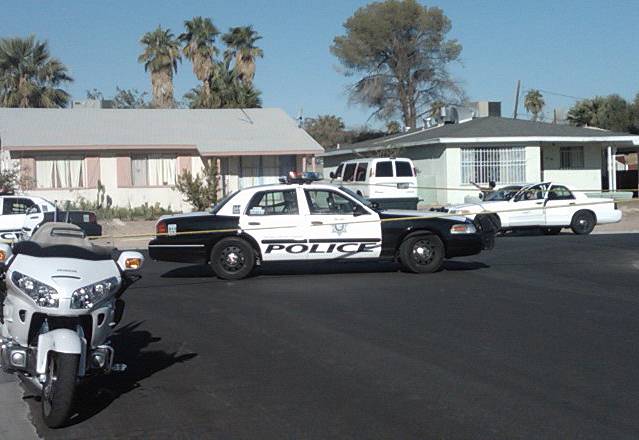
Metro Police investigate a shooting near St. Louis Avenue and Maryland Parkway that left an 80-year-old woman dead in this Sept. 24, 2009, file photo. Police said the woman’s 86-year-old husband shot her, then turned the gun on himself as part of a pact to end the couple’s suffering from health problems. The man survived the shooting but died later that year.
Tuesday, Sept. 20, 2011 | 4:33 p.m.
Nevada ranks highest for women killed by men
KSNV coverage of the increasing rate of women murdered by men, Sept. 20, 2011.
Highest male-on-female rate of killings per 100,000 residents
- 1. Nevada - 2.7
- 2. Alabama - 2.64
- 3. Louisiana - 1.99
- 4. Arizona - 1.92
- 5. Tennessee - 1.83
- 6. Georgia - 1.8
- 7. South Carolina - 1.79
- 8. South Dakota - 1.72 (tie)
- 9. Hawaii - 1.72 (tie)
- 10. Missouri - 1.7
Sun Topics
Sun Archives
Nevada’s rate of women killed by men — more than double the national average — ranks first in the nation for the second consecutive year, according to a report released today.
Nevada has taken the unenviable top spot four of the past five years in the “When Men Murder Women” report released by the Violence Policy Center, a Washington, D.C.-based nonprofit organization that studies gun violence. This year’s report analyzes homicides from 2009, the most recent data available from the FBI.
Nevada’s homicide rate of women killed by men in 2009 was 2.7 per 100,000, according to the report. The national average was 1.25 per 100,000.
Alabama and Louisiana followed Nevada in the report’s homicide rate rankings.
Police say the gloomy portrait of domestic violence in Nevada, however, isn’t necessarily accurate now.
Metro Police Lt. Rob Lundquist of the department’s domestic violence detail said domestic violence-related homicides in Las Vegas have been decreasing since the report’s data were collected. There have been five female homicide victims related to domestic violence so far this year in Metro’s jurisdiction, he said.
“We’ve definitely had a substantial reduction in domestic violence-related homicides and also female fatalities,” Lundquist said. “We’ve taken a very active stance on it.”
The Violence Policy Center’s report studied female homicides nationwide in 2009 involving a single male offender and a single female victim. There were 35 cases that fit that description in Nevada.
Those included 26 in Las Vegas, six in North Las Vegas and one each in Reno, Storey County and Winnemucca, according to 2009 data used in the report.
Kristen Rand, legislative director at the Violence Policy Center, said the top states tend to have limited resources available to women in abusive relationships, as well as depressed economies and easier access to guns.
Explaining how the economy plays a role, Rand said: “What tends to happen is families get stressed. They feel like they have nowhere to turn.”
Even so, Rand noted that only “spotty research” has been done regarding factors contributing to homicides. The report’s findings, however, make it clear domestic violence is the underlying issue in many cases, with black women suffering the most.
Black women were killed by men at a rate almost 2 1/2 times higher than that of white women — 2.62 per 100,000 compared to 1.05 per 100,000, according to the report.
In most cases, the female homicide victims knew the male suspects, and arguments often preceded the slayings. Of those who knew the male suspects, 63 percent were wives or intimate acquaintances of the accused killers, according to the report.
The report also placed emphasis on the relationship between gun possession and homicide, stating that “a gun in the home is a key factor in the escalation of nonfatal spousal abuse to homicide.”
Nationally, 52 percent of the homicides studied for the report involved a firearm as the weapon, officials said. In Nevada, 50 percent of the women in 2009 were killed by guns, 80 percent of which were handguns.
“Nevada has a much stronger gun culture than, say, California,” Rand said. “You just have more guns in circulation.”
Lundquist credited a community approach in recent years for the local drop in female homicide victims since 2009. He cited organizations dedicated to helping women escape domestic violence, such as Safe Nest and The Shade Tree, in addition to Metro’s own initiatives.
“Domestic violence takes a community response, and we have very committed people to do that,” he said. “I think that’s why we’ve seen those numbers start to decline, because the economy hasn’t gotten any better.”

Join the Discussion:
Check this out for a full explanation of our conversion to the LiveFyre commenting system and instructions on how to sign up for an account.
Full comments policy